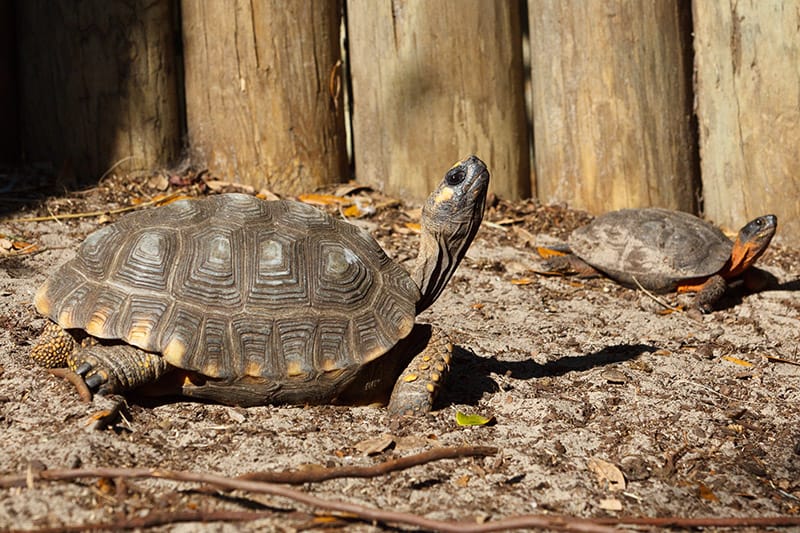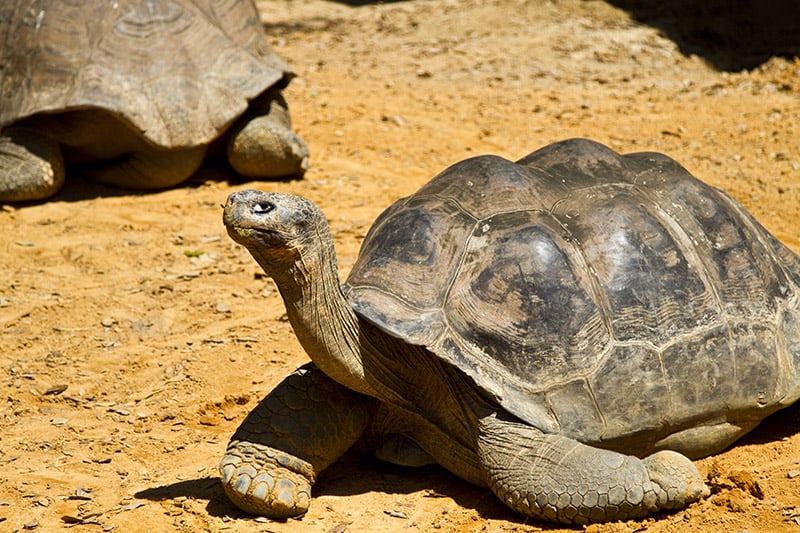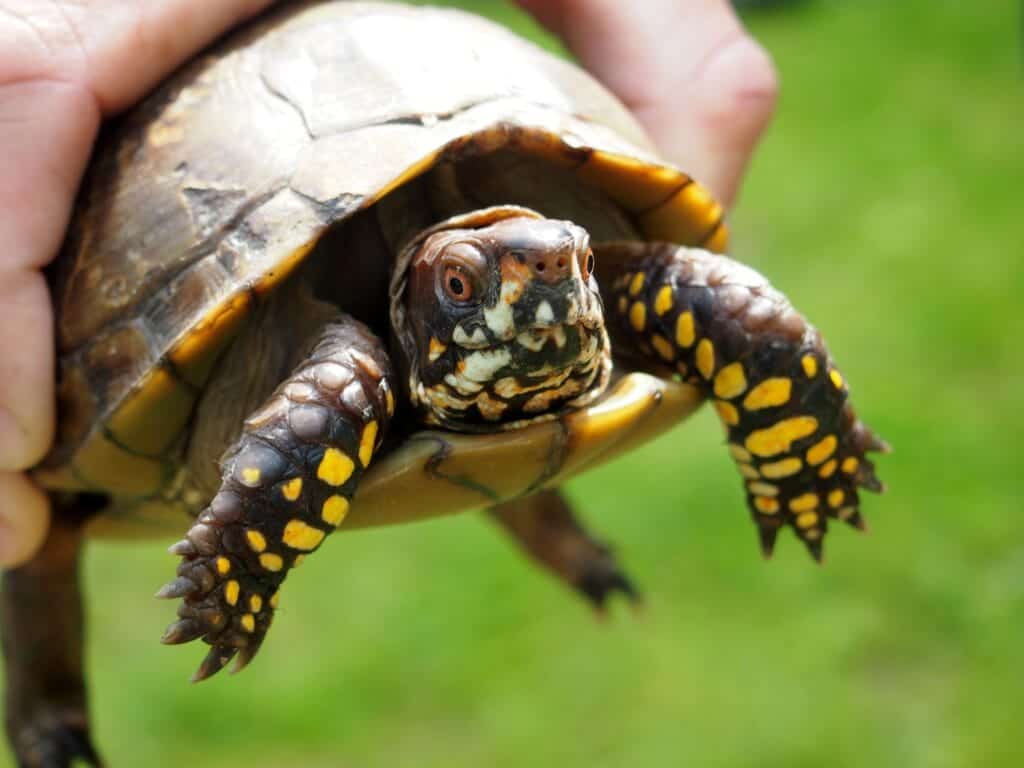The Yellow-foot Tortoise is a very attractive and sought after tortoise!
Yellow-foot Tortoises are not as colorful as their kin, the Red-footed Tortoise, and they have the reputation of being more delicate. Even so, captive-hatched Yellow-foot Tortoises are among the best pet tortoises. They are very personable and fairly easy to keep.
Though they are typically very shy tortoises, the Yellow-foot Tortoises are fairly large and quite active. Like all tortoises they are also quite long-lived. Provide a good environment with plenty of space to exercise, a variety of shelters to give them a feeling of security, and the proper diet, and they can make wonderful pets.
- For more information see: Selecting and Caring for Your Turtle or Tortoise
Scientific Classification
| Kingdom: | Animalia |
| Phylum: | Chordata |
| Class: | Reptilia |
| Order: | Testudines |
| Family: | Testudinidae |
| Genus: | Geochelone |
| Species: | denticulata |
Distribution
Red-footed Tortoises are found in the tropical and humid forest areas of South America. They inhabit Guianas, Venezuela, Brazil, Ecuador, Columbia, Paraguay, Peru, Surinam, and there are some on the Caribbean islands. They live in the underbrush and forage for fallen fruit, plant growth, and will even eat carrion.
Status
This tortoise is listed on the IUCN Red List of Threatened Species: VU – Vulnerable and and listed on CITES: Appendix II.

Description
Though quite similar in appearance to their kin, the Red-footed Tortoise, the Yellow-foot Tortoise is not quite as colorful. The primary distinction between these two tortoises is the color of the scales on their front legs, and thus their common names. There is a presence of yellow scales on the front legs of the Yellow-footed Tortoise rather than the red scales of the Red-footed Tortoise.
A few other distinctions of the Yellow-foot Tortoise are a light golden brown background shell color though the background color of the head and limbs are also dark. These tortoises also tend to have a bit wider and flatter overall shape, and they lack the ‘hourglass’ form of the carapace (upper shell) that is characteristic of the adult male Red-footed Tortoise. Size-wise, they are a bit larger with some specimens reaching 26″ – 28″ (66 – 71 cm), though most will only reach 14″ – 16″ (35 – 41 cm). Males tend to have an even flatter carapace than the females, longer and wider tails, and a very concave plastron (bottom shell).
Care and Feeding
Yellow-foot Tortoises are omnivores, eating both animal and plant material in nature. In captivity they will feed eagerly on a mixed salad of fruits and vegetables every other day. They should also be fed some higher protein items once or twice a week. Dead mice, Mazuri Tortoise Diet®, Zupreem Primate Diet®, and other commercial foods are also great additions to the Yellow-foot Tortoise’s diet.
Water should be offered in a large flat saucer. This can be a cat litter pan sunk into the substrate (make sure the tortoise can climb in and out easily) or a large plastic saucer which is normally placed under a potted plant. These can be easily cleaned and sterilized once a week or as needed.
Environment
Yellow-foot Tortoises are found in tropical and humid forest areas. They live in the underbrush and forage for fallen fruit, plant growth, and will even eat carrion. A pair of adults will require an enclosure that is at least 4′ wide x 6′ long.
The substrate can be a mixture of ½ sand and ½ peat moss. A layer of cypress mulch should be placed over the top of the substrate to help hold in moisture. The substrate can be kept dry if a large water source is provided, such as a shallow flower pot for small specimens and a tub for larger specimens. The space underneath the Yellow-foot Tortoise’s favorite shelter should be sprayed with water once or twice a week to keep this area damp.
Typically being a very shy tortoise, Yellow-foot Tortoises appreciate a variety of shelters to give them a feeling of security. Add large pieces of curved cork bark, large banana leaves, piles of straw or hay, or grass clippings for the tortoises to use as shelter. The shelter should be located at the cooler end of the enclosure and not directly under the heat-emitting lamps.
Provide heat using a heat-emitting bulb in a clamp-type fixture over the enclosure. Ideally, you can hang a fixture overhead that will hold the bulb and keep it about 12″ above the surface of the substrate. Most of these bulbs get very hot and so should be kept in a fixture with a ceramic base. The heat-emitting bulbs should provide a basking spot of 90{deg} F (32{deg} C) at one end of the enclosure. The heat in this area will allow the Yellow-foot Tortoise to bask and to digest its food properly.
Lighting can be provided with a shop light fixture overhead that is fitted with one or two UV-emitting bulbs. These can be found at your pet store or on-line from a variety of sources. UVB-heat bulbs® from T-Rex products and Zoomed Reptisun® bulbs will provide UV radiation to the enclosure. This UVB is necessary for Vitamin D3 synthesis, which allows the tortoises to properly use calcium and to carry on metabolism.
Indoors:
The most common form of indoor accommodation for small or medium sized Yellow-foot Tortoises is a large terrarium. You can also use plastic tubs, wooden cages, and other enclosures. Glass terrariums are easy to find at the local pet store and they come in a variety of sizes. Of course, as the tortoise grows, it will need larger and larger enclosures.
Outdoors:
Yellow-foot Tortoises benefit from being kept outdoors for all or part of their lives. They received doses of UVB radiation, environmental heat, and of course enjoy a connection to the grass, plants, and soil found in outdoor pens. Outdoor enclosures should offer shelter from heat, a secure place to rest, and a water source. Food offered to tortoises and can be supplemented by plantings of some of their favorite grasses, fruits, and vegetables within the enclosure. Also be very diligent to make sure that outdoor enclosures are escape-proof and predator-proof.

Handling
As a shy species, most Yellow-foot Tortoises will not enjoy being handled. They will often retreat into their shells and stay tightly wedged in with their large, scaly legs covering their heads. Of course, there are always exceptions. Occasionally very outgoing, almost tame, Yellow-foot Tortoises are seen. These are usually specimens that have been raised from small, captive-hatched babies and which are open to daily interaction over many years.
Breeding
An established pair of Red-footed Tortoises can be very prolific and in warm areas can produce year-round. A light winter cooling, followed by warm, rainy days triggers breeding in Yellow-foot Tortoises. Males are typically eager breeders and a healthy pair can produce two clutches of 6 to 12 eggs each season, depending on the size of the female. These clutches are typically laid four to six weeks apart.
It is felt by most keepers that the addition of protein and calcium to female Yellow-foots’ diets is essential in having them produce clutches of healthy, viable eggs. The young Yellow-foots hatch in 100 to 120 days when incubated at 84{deg} F.
Ailments / Health Problems
As with most other tortoises Yellow-foot Tortoises are found in warm habitats. Thus, their captive enclosures should reflect this need. When kept cool for an extended period of time, you can expect a Yellow-foot Tortoise to begin showing respiratory problems. The early signs are puffy eyes, runny noses, etc. You should strive to maintain an enclosure that is hot and humid (but not soggy) to avoid these health issues.
Be Aware:
REMEMBER: Ivermectin, a famous wormer in the cattle industry, |
Long-term lack of appetite, runny or smelly stools, and blood in the feces are signs of a problem and a keeper should approach a qualified veterinarian if any of these signs are noticed.

Availability
Yellow-foot Tortoises are available from better reptile stores, on-line, or at reptile shows and expos. Though captive breeding of Yellow-foot Tortoises is nowhere near that of Red-footeds, Leopards, or sulcatas, there is some production happening in the U. S. and captive-hatched specimens are increasing in numbers.
Try to purchase your tortoise from a breeder or someone with intimate knowledge of tortoises. Be careful when purchasing a tortoise on-line. There are many many imported Yellow-foot Tortoises arriving into the pet trade (see ailments above). These animals are definitely not the best for beginning keepers. Actually for most keepers, wild-caught Yellow-foots should be avoided. Recently imported Yellow-foots are typically stressed, dehydrated, and will harbor a variety of internal parasites.
Captive-hatched animals from a breeder are an excellent choice. A breeder will help you set up the proper enclosure and will give you helpful hints so you are successful. Also, if you don’t have to ship your tortoise, that is always best. A beginning keeper should purchase a tortoise that is at least three months old to make sure it is past the delicate stage.
Featured Image Credit: JumpStory
